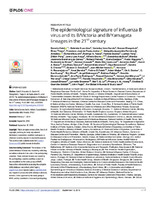Please use this identifier to cite or link to this item:
http://sgc.anlis.gob.ar/handle/123456789/1371| Title: | The epidemiological signature of influenza B virus and its B/Victoria and B/Yamagata lineages in the 21st century | Authors: | Caini, Saverio Kusznierz, Gabriela F. Garate, Verònica Vera Wangchuk, Sonam Thapa, Binay de Paula Júnior, Francisco José Ferreira de Almeida, Walquiria Aparecida Njouom, Richard Fasce, Rodrigo A Bustos, Patricia L. Feng, Luzhao Peng, Zhibin Araya, Jenny Lara Bruno, Alfredo de Mora, Doménica Barahona de Gámez, Mónica Jeannette Pebody, Richard Zambon, Maria Higueros, Rocio Rivera, Rudevelinda Kosasih, Herman Castrucci, Maria Rita Bella, Antonino Kadjo, Hervé A Daouda, Coulibaly Makusheva, Ainash Bessonova, Olga Chaves, Sandra S Emukule, Gideon O Heraud, Jean-Michel Razanajatovo, Norosoa H Barakat, Amal El Falaki, Fatima Meijer, Adam Donker, Gé A Huang, Q Sue Wood, Tim Balmaseda, Angel Palekar, Rakhee Arévalo, Brechla Moreno Rodrigues, Ana Paula Guiomar, Raquel Lee, Vernon Jian Ming Ang, Li Wei Cohen, Cheryl Treurnicht, Florette Mironenko, Alla Holubka, Olha Bresee, Joseph Brammer, Lynnette Le, Mai T Q Hoang, Phuong V M El Guerche-Séblain, Clotilde Paget, John |
Issue Date: | 2019 | Journal: | PloS one | Abstract: | We describe the epidemiological characteristics, pattern of circulation, and geographical distribution of influenza B viruses and its lineages using data from the Global Influenza B Study. We included over 1.8 million influenza cases occurred in thirty-one countries during 2000-2018. We calculated the proportion of cases caused by influenza B and its lineages; determined the timing of influenza A and B epidemics; compared the age distribution of B/Victoria and B/Yamagata cases; and evaluated the frequency of lineage-level mismatch for the trivalent vaccine. The median proportion of influenza cases caused by influenza B virus was 23.4%, with a tendency (borderline statistical significance, p = 0.060) to be higher in tropical vs. temperate countries. Influenza B was the dominant virus type in about one every seven seasons. In temperate countries, influenza B epidemics occurred on average three weeks later than influenza A epidemics; no consistent pattern emerged in the tropics. The two B lineages caused a comparable proportion of influenza B cases globally, however the B/Yamagata was more frequent in temperate countries, and the B/Victoria in the tropics (p = 0.048). B/Yamagata patients were significantly older than B/Victoria patients in almost all countries. A lineage-level vaccine mismatch was observed in over 40% of seasons in temperate countries and in 30% of seasons in the tropics. The type B virus caused a substantial proportion of influenza infections globally in the 21st century, and its two virus lineages differed in terms of age and geographical distribution of patients. These findings will help inform health policy decisions aiming to reduce disease burden associated with seasonal influenza. |
URI: | http://sgc.anlis.gob.ar/handle/123456789/1371 | DOI: | 10.1371/journal.pone.0222381 |
| Appears in Collections: | Publicaciones INER |
Files in This Item:
| File | Description | Size | Format | |
|---|---|---|---|---|
| journal.pone.0222381.pdf | Artículo en inglés | 1.14 MB | Adobe PDF |  View/Open |
Page view(s)
187
checked on Jan 17, 2026
Download(s)
23
checked on Jan 17, 2026
Google ScholarTM
Check
Altmetric
Altmetric
Items in DSpace are protected by copyright, with all rights reserved, unless otherwise indicated.

